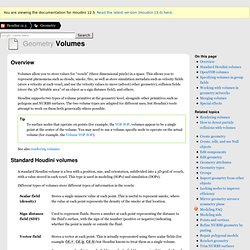

Are there any resources on volumes alone? You can think of the point as simply storing the position of the volume.

Volumes can also be translated, rotated and so on like other objects. A fog volume stores a value representing whether a particular voxel is inside the surface - so 1 if it is fully inside, 0 if fully outside. If the surface cuts through a voxel the value will be between 0 and 1 depending on how much of the voxel is inside the surface. The fog volume naturally extends to representing, er, fog, and similar things where the density of the substance - fog, smoke, flame etc varies from voxel to voxel. SDFs are the other way of representing a surface as a volume, and make most sense for things like liquids, where there is a well defined inside and outside, rather than fog where what we are interested in is the density at a given point.
"Pyroclastic noise" demystified - Shaders.
Volume Texture Mapping. No problem...

Du(), Dv(), Dw() are almost always just used for technical purposes: for antialiasing your shading mostly. These values return the change in any of a shader value between adjacent samples in the u, v, or w directions. This allows a shader-writer to know how to make sure that his shader doesn't twinkle, and other things. Du(P) gives the change in position (so useful it also comes in the dPdu/v/z "derivative" flavours), which is most useful for thing like noise where you want to limit your feature sizes so that features don't wink in and out of existence as your object gets diced more or less as you change your range to your surface.
The AntiAliased Noise VOP already listens to this, as does texture(), for it to select the most appropriate (prefiltered) mip-map of a texture. Documentation.
Merge object using level set. Volumes. An OpenVDB volume uses the OpenVDB library to represent a sparse volume very efficiently.

A VDB volume uses essentially no memory for “empty” voxels (technically, voxels equal to the “background value”). This volume type is useful for modeling sparse volumes such as clouds and wispy smoke. Because of the way this volume type is represented in memory, it does not require that you specify a box containing the volume; it can extend infinitely. Despite this, a VDB does define a 3D grid of voxels over the whole space. OpenVDB volumes were added to Houdini in version 12.5. You can write OpenVDB volumes to bgeo files and load them at render time using the Mantra delayed load procedural, just as with standard Houdini volumes/geometry. Fluid mapping. Fluid velocity render. 'anim', on 14 Jun 2011 - 11:31 PM, said: you can rename vel.x, vel.y and vel.z volume primitives to Cd.x, Cd.y and Cd.zor for more control you can directly access "vel" in any volume shader, transform it to screen space, scale accordingly for RSMB and plug instead of Cd node ok thanks I will try to do.

Vex Volume Procedural. VEX Volume Procedural. Quote i ran into this a few months ago and reported it as a bug to sesi, i believe they've fixed it since, so maybe re-upping your h. version might work?

Wow, good news brianburke, we use a bit outdated build at work ( i guess 581 ), i'll try last build tomorrow.Thank you guys for reply.I'm in the process of learning volumes in houdini, so correct me if i'm wrong. But you can make a mountain from a quad using a displacement shader. I was wondering why the volume would become so huge, if it was something specific for the i3d method of making clouds, or if it is simply a very big volume that needs to contain multiple clouds Well, volume displacement is different from surface displacement. On that note, could you elaborate a little why the I3d? I haven't much experience with with volumes, and i didn't test bgeo vs i3d, but for now, i see following advantages of I3d textures:1.
I3D generation from 2D images sequence. Non-square voxel sizes. So as it's been explained to me: Houdini supports non-cubical voxels.

In fact, its volumes are stored as a unit cube at the lowest level which is then scaled up to the correct dimensions. Due to the floating point scaling the world space voxel size often ends up not quite cubical even when this has been specified in a Houdini node (e.g. specifying a Div Size in Volume Resize). I've found that (for instance), with a fluid Division Size of 0.3, I get voxel sizes like this: (0.299988 0.3 0.299999). For reasons I have no power to affect, this causes a problem for the proprietary software here, which expects voxels to be square to the sixth decimal place. Obviously, the problem is worse when resizing the fluid on every frame - but it seems to be a problem even if I lock the size, and just translate it. Modelling as Volume Sampling. What are volume and iso offset sops.
Sculpting volumes. I've responded to some of your questions below.

"I hope nobody minds if join in and maybe ask a few questions about the above file / iso offset workflow. Sculpting animated volumes. Volume Modeling Plug-in. Volume Modeling Plug-in.